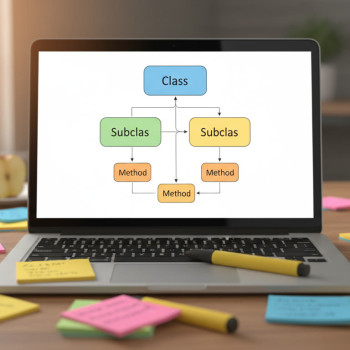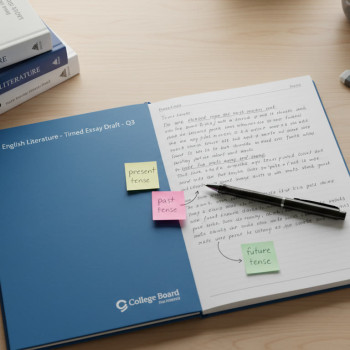Why the CED Matters (And Why You Should Care)
If you’re taking an AP science course — Biology, Chemistry, or Physics — the Course and Exam Description (CED) is your roadmap. Think of it as the syllabus the College Board designed for every teacher and student: it tells you what content shows up on the exam, which skills are tested, how the exam is structured, and what kinds of evidence you’ll be expected to give. But most students glance at it once and never return. That’s a missed opportunity. Read it right and the CED becomes the single best study tool you own.

What the CED Is — and Isn’t
The CED is not a textbook, a set of practice questions, or a teacher’s lesson plan. Instead, it’s concise, official, and intentionally prescriptive: unit weightings, learning objectives, science practices, sample exam tasks, and reference sheets. It’s the authoritative “what matters.” Use it to prioritize what to study and how to practice, not to learn every tiny detail in isolation.
First Read: Get the Big Picture in 20–30 Minutes
Your first pass should be fast and strategic. You’re not reading to master content yet — you’re mapping the territory.
- Scan the table of contents to see the units and sections layout.
- Note exam format and timing: how many multiple-choice vs free-response, sections, and time allotments.
- Find the list of science practices or skills. These are the verbs the exam uses — analyze, interpret, design, model — and they tell you how you’ll be assessed.
- Check unit weightings (percent ranges) so you know what deserves the most study time.
This quick orientation turns the long PDF into a usable map: you’ll know where the high-value terrain is and which pathways lead to the exam’s “treasure” (high-point topics).
Quick-Start Checklist (First Read)
- Open the CED and mark the exam format and timing.
- Highlight unit names and % weights.
- Underline the listed science practices and quantitative skills.
- Flip to sample questions or course at a glance to see question types.
Second Read: Extract the Exam’s Language and Expectations
Now dive deeper, focusing on the language the College Board uses. Exam graders love precise words; the CED uses the same vocabulary as scoring rubrics and sample responses. Learning to think in that language is a huge advantage on free-response questions.
Pay Attention to:
- Command words and verbs — e.g., explain, describe, predict, evaluate, justify.
- Performance expectations for each unit — what students should be able to DO.
- Sample tasks and rubrics — they show exactly how responses are scored.
Translate these expectations into study habits: if a unit expects you to “analyze models,” add more practice interpreting graphs and diagrams than rote memorization.
Practical Strategy: Turn the CED into a Study Plan
A CED without a plan is a fancy document. Here’s how to convert it into a living schedule you’ll actually use.
Step 1 — Prioritize by Unit Weight and Weakness
Make a two-axis decision: how much the unit counts on the exam and how comfortable you are with it. High weight + low comfort = highest priority. Low weight + high comfort = review later.
Step 2 — Map Skills to Weekly Goals
For each week, pick one content priority and one skill priority. For example: Week 1 — “Equilibrium (Unit 5): calculate K and interpret shifts” and “Skill: Model analysis and constructing graphs.” That keeps content study tied to how you’ll be tested.
Step 3 — Active Practice That Mirrors the Exam
- Multiple-choice: practice with timed sets that include data interpretation and reasoning.
- Free-response: practice writing concise, evidence-based answers; practice under timed conditions, then compare to sample rubrics in the CED.
- Make a mini-lab or data-interpretation set from a chapter — design, predict, test, and explain as though you were writing a short response.
Use the CED’s Quantitative and Lab Expectations Like a Checklist
For science APs, the CED usually has a list of required quantitative skills and lab investigations or practices. Treat this list as the backbone of your practical prep.
| CED Section | What to Extract | How to Practice |
|---|---|---|
| Unit Weightings | Priorities for study time | Allocate study hours weekly according to weights |
| Science Practices / Skills | Verbs used on the exam (analyze, model, interpret) | Build skill-focused practice sets and timed rubrics |
| Quantitative Skills List | Equations, calculations, data manipulation required | Daily problem sets and calculator familiarity practice |
| Investigative Labs / Lab Skills | Expected lab experiences and how to report results | Write mock lab reports and practice summarizing data |
How to Read Sample Questions and Rubrics Efficiently
The CED typically includes sample exam tasks and grading notes. These are gold. But don’t just read them—reverse-engineer them.
Reverse-Engineering Steps
- Read the question and try to answer it under timed conditions.
- Compare your answer to the sample answer and rubric.
- Identify where your answer diverged: missing claim, weak evidence, or poor organization.
- Make a short checklist of the rubric’s requirements and use it when practicing similar questions again.
Over time you’ll internalize the rubric: your answers will start to look like what graders expect, which often means clearer points, specific evidence, and clean organization.
Active Reading Techniques That Make the CED Stick
Passive reading won’t cut it. Use active techniques to keep the CED working for you.
Annotation System (Simple and Effective)
- Color 1 — Yellow: Unit weight or topic to prioritize.
- Color 2 — Green: Exact skill/verb the exam uses (“explain,” “predict”).
- Color 3 — Pink: Sample question or rubric tip you’ll use in practice.
Make Margin Prompts
Next to any sample question, write a 1-line prompt you’ll use later when practicing — for example, “Claim? Evidence? Reasoning?” or “Graph first: label axes and trend.” A two-minute margin note can save you ten minutes in later practice.
Integrating Active Study Tools and Personalized Help
Reading the CED is best paired with tools that help translate it into practice: flashcards for definitions, data-interpretation sets for quantitative skills, and targeted tutoring for tricky units. Personalized tutoring — like Sparkl’s 1-on-1 guidance — can be especially useful when your CED analysis shows a persistent weakness. An expert tutor can build tailored study plans directly mapped to the CED, run mock FRQs with rubric-based feedback, and suggest AI-driven insights to track progress efficiently.
When to Seek 1-on-1 Support
- If your practice FRQ scores plateau despite steady study.
- If you struggle to convert CED verbs into practice tasks.
- If you need a customized pacing plan based on your school’s calendar or personal commitments.
Sample Two-Week Sprint Using the CED
This sprint assumes you’ve already done the first and second reads. It’s for a high-priority, high-weight unit (for example, Equilibrium in Chemistry or Genetics in Biology).
| Day | Focus | CED-Based Task | Outcome |
|---|---|---|---|
| 1 | Read Unit Section | Extract learning objectives and quantitative skills | Personal checklist of what to master |
| 2 | Core Concepts | Synthesizing summary in your own words | 1-page condensed notes |
| 3 | Quantitative Skills | Do 10 targeted calculations listed in CED | Problem set + worked solutions |
| 4 | Model Analysis | Practice interpreting 3 sample models from CED | Annotated models |
| 5 | Practice MCQs | Timed set of 20 questions | Review mistakes using CED verbs |
| 6 | Free Response | Write one FRQ that maps to unit rubric | Feedback checklist and rewrite |
| 7 | Review | Consolidate errors and make a 1-page cheat sheet | Master summary |
Using the CED to Guide Lab and Investigation Prep
AP science CEDs describe either required investigations or investigative skills. Even if your classroom doesn’t run every suggested lab, you can still practice the investigative skills on paper: analyze data sets, design an experiment in steps, or critique a procedural design for sources of error.
Mock-Lab Practice Template
- Goal: State the hypothesis and how you’d test it.
- Variables: Identify independent, dependent, and controlled.
- Procedure summary: 5 steps max, clear enough to replicate.
- Data handling: Show sample data and how you’d graph/interpret it.
- Conclusions and uncertainty: Write claims with evidence and list sources of error.
Use the CED’s lab language to make sure your mock lab answers would satisfy a rubric. If you get stuck on procedural design or data analysis, that’s a perfect moment to bring a targeted tutoring session into play — tutors can simulate the role of instructor and grader, giving you focused, rubric-informed feedback.
Common Reading Mistakes and How to Avoid Them
- Reading the CED like a textbook: It’s a map, not a lesson plan. Extract priorities, not full content.
- Ignoring the verbs: Skills are often the difference between a 3 and a 5 on FRQs.
- Not practicing the exact task formats shown in the CED: replicate the format, timing, and rubric in practice.
- Failing to update study plans: re-check the CED after each practice exam to shift priorities.
How to Track Progress Against the CED
Make a simple tracking sheet that ties every practice activity back to a CED item. Here’s a compact format you can use in a notebook or spreadsheet.
| CED Item | Practice Activity | Score/Result | Next Action |
|---|---|---|---|
| Quant Skill: K calculations | 10 problem set | 7/10 (timed) | Review errors, redo 5 similar |
| Lab Skill: Error analysis | Mock lab write-up | Score: Needs more uncertainty discussion | Practice uncertainty paragraph with tutor |
Example: Translating a CED Verb into Practice
CED instruction: “Analyze models and representations to explain phenomena.” Translation into practice: choose a figure or graph, ask two questions (what does it show? what conclusion follows?), write a 3-sentence claim backed by two pieces of evidence, and include one uncertainty or limitation. Time it. Then compare against the CED sample responses. This habit trains your brain to answer exactly what the rubric demands.
How to Maintain Momentum During Busy Weeks
AP season collision courses — midterms, sports, family events — can derail the best plans. Use CED-based micro-practice: 20–30 minute focused sessions that map to one verb or one quantitative skill. A single timed FRQ passage or three targeted calculations keeps progress moving without derailing life.
Micro-Practice Example
- 15 minutes: Read CED rubric for a short response.
- 20 minutes: Write a 6–8 sentence response to a past question aligned with that rubric.
- 10 minutes: Check against the CED checklist and mark one improvement for next time.
Final Weeks: Synthesis, Not Cramming
In the final month before the exam, use the CED as your exam checklist: revisit unit weightings, practice high-yield FRQs from each unit, and confirm mastery of quantitative lists and lab expectations. Simulate exam conditions at least twice — one full timed practice and one targeted practice focusing only on your weakest CED items.
Wrapping Up: Make the CED Your Study Companion
Reading a CED efficiently is less about volume and more about translation: turning official language into daily practice. Use quick reads to map priorities, deeper reads to extract the verbs and rubrics, and then build a plan that ties every practice activity back to something in the CED. Along the way, small tools — a personalized tutoring session to address a stubborn skill, a weekly progress sheet, or AI-driven practice insights — can speed up improvement and keep you accountable.
When you treat the CED as a living document rather than a PDF to be ignored, your study becomes smarter and more surgical. You focus where points actually come from, respond in the language graders expect, and build real confidence. Keep it organized, keep it active, and keep returning for targeted reviews — your future self (and your AP score) will thank you.

Parting Advice
Start early, read intentionally, and practice like a grader. If you ever feel stuck translating a verb into a practice task or matching your answers to a rubric, consider a short, focused session with a tutor who can align your practice to the CED exactly — that’s often the most efficient way to convert effort into score gains.
Good luck — read smart, practice deliberately, and let the CED guide your way.




















No Comments
Leave a comment Cancel